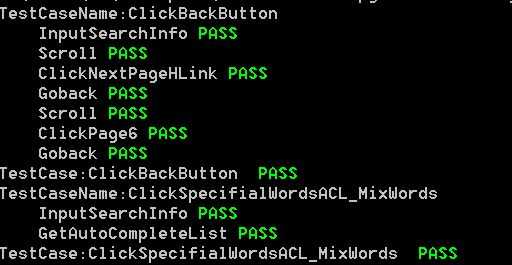这个还是我在刚开始学习selenium的时候做的,自己觉得有点意思,在接下来我会基于目前我对于selenium的一些深入研究,写下我对selenium的理解以及UIAutomation的一些理解,以此开篇吧^_^
前段时间研究Selenium,写了一些测试网页的代码,写着写着,就感觉这些自动化cases的相似度太高,多数是大同小异,基本上可以归纳为这样三步1)找到元素 2)进行操作, 比如点击或者滑动 3) 验证期望, 比如跳转到了一个新页面,或者新元素出现在屏幕中.
比如下面:
from selenium import webdriver from selenium.webdriver.support.wait import WebDriverWait def web_automation(): browser=webdriver.Chrome() browser.get(‘http://www.baidu.com/‘) Input_element=browser.find_element_by_id(‘kw‘) Input_element.send_keys(‘Selenium‘) browser.find_element_by_id(‘su‘).click() result=browser.find_element_by_xpath(‘//*[@id="container"]/div[2]‘).is_displayed() assert result!=True,"Failed"
写的多了,这时候就想,能不能有什么模板,让我们快速的创建一条case,甚或者能让一个不会Selenium的Tester也能写自动化case呢。
说做就做,最后就搞出来了下面一个雏形, 我们可以定义这样的一个XML:
<TestCase name="ClickBackButton" scriptVersion="1.0.0"> <Executable>Chrome</Executable> <Address>http://www.baidu.com</Address> <Action Operate="InputSearchInfo" Type="Input" ID="kw" Content="Glow"/> <Action Operate="Scroll" Type="Scroll" /> <Action Operate="ClickNextPageHLink" Type="Click" XPath=‘//*[@id="page"]/a[10]‘> <Expected XPath=‘//*[@id="page"]/strong/span[2]‘ Text="2" /> </Action> <Action Operate="Goback" Type="Back"> <Expected XPath=‘//*[@id="page"]/strong/span[2]‘ Text="1" /> </Action> <Action Operate="Scroll" Type="Scroll" /> <Action Operate="ClickPage6" Type="Click" XPath=‘//*[@id="page"]/a[5]‘> <Expected XPath=‘//*[@id="page"]/strong/span[2]‘ Text="6" /> </Action> <Action Operate="Goback" Type="Back"> <Expected XPath=‘//*[@id="page"]/strong/span[2]‘ Text="1" /> </Action> </TestCase>
然后我们就可以这样来解析:
第一步解析XML生成TestCase的list,在例子中就一个Testcase:
import xml.etree.ElementTree as ET import logging import os import sys import traceback from TestCase import TestCase class ParseCase: def __init__(self,xml_path): if os.path.exists(os.getcwd()+"\\"+xml_path) or os.path.exists(xml_path): self.caseList=[] try: xml=ET.parse(xml_path) root=xml.getroot() self.caseList=root.find(‘TestList‘).findall(‘TestCase‘) except IOError as e: print traceback.format_exc() logging.debug(traceback.format_exc()) if self.caseList: logging.info(‘No Testcase detected‘) else: logging.info(‘No Testcase detected‘) else: print "XML file is not exists" logging.debug("XML file is not exists") def getAllTestCaseList(self): TestCases=[] for case in self.caseList: _testcase=TestCase(case) TestCases.append(_testcase) return TestCases
第二步, 根据每个testcase建立TestCase类的实例:
class TestCase: def __init__(self, _testcase): self.name=_testcase.attrib[‘name‘] _list=[] self.actions=[] try: _list=_testcase.getchildren() except Exception,msg: print msg self._executor=_testcase.find(‘Executable‘).text self.address=_testcase.find(‘Address‘).text for act in _testcase.findall(‘Action‘): if act.tag==‘Action‘: _action=Action(act) self.actions.append(_action) def setUp(self): if ‘Chrome‘==self._executor: self.executor=webdriver.Chrome() elif ‘Firefox‘==self._executor: self.executor=webdriver.Firefox() else: self.executor=webdriver.Ie() self.executor.get(self.address) def tearDown(self): self.executor.quit() def execute(self): logging.debug("Start to execute the testcase:%s" % self.name) print "TestCaseName:%s" % self.name try: self.setUp() for action in self.actions: action.execute(self.executor); self.tearDown() Assert.AssertPass("TestCase:%s " % self.name) except Exception as error: print error self.tearDown() Assert.AssertFail("TestCase:%s " % self.name)
第三步,根据xml里定义的type来触发动作,我就简单的列了下:
def execute(self,executor): _type=self._actions[‘Type‘] self.getBy(self._actions) try: if self.by!=None: ele=self.findElement(executor) Assert.AssertIsNotNull(ele," ".join("Find element by %s:%s" % (str(self.by),self.by_value))) if _type==‘Input‘: ele.send_keys(self._actions[‘Content‘]) time.sleep(3) elif _type==‘Click‘: ele.click() elif _type==‘Scroll‘: webOperate.page_scroll(executor) elif _type==‘Back‘: webOperate.goBack(executor) else: print " ", Assert.AssertFail(self._name) print "No such action:%s" % _type if self._expected is not None: Assert.AssertIsTrue(self.isExpected(executor)," ".join("Find element by %s:%s" % (str(self.by),self.by_value))) print " ", Assert.AssertPass(self._name) except AssertionError: print " ", Assert.AssertFail(self._name) raise AssertionError(self._name +" execute failed")
看一个运行的截图

代码比较简单,原理也很清晰,就是解析XML文件,然后调用相应的selenium代码,但是如果我们再深入的想想,在解析这些XML的时候,是不是可以以更友好的方式来展示生成的代码呢,甚或者以UI的方式,一条条展示。然后再提供可编辑功能?甚或者再提供录制的方式来自动生成这些XML文件,再解析成代码,这不就是一个强大的自动化测试工具??
原文:http://www.cnblogs.com/baibai-tech/p/4290992.html